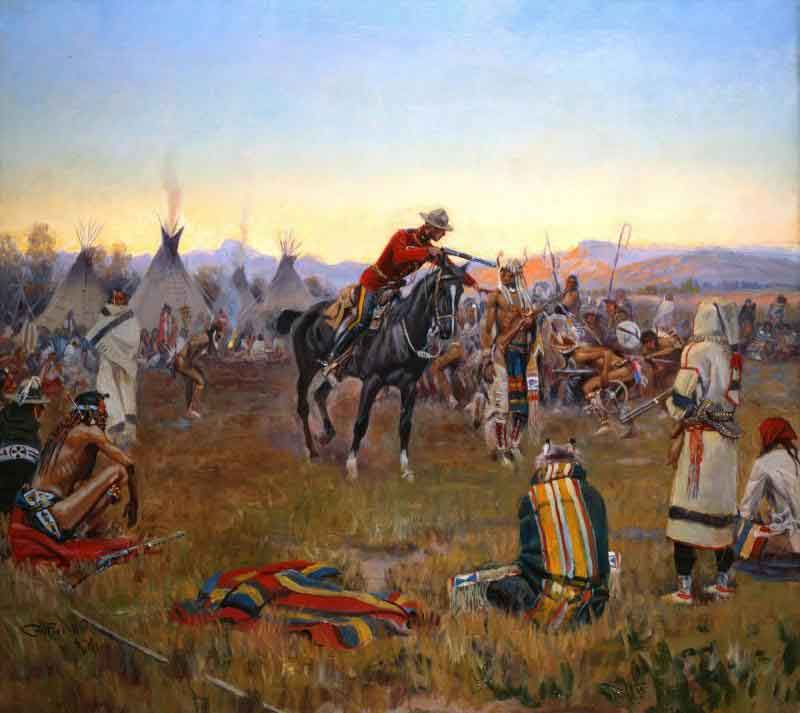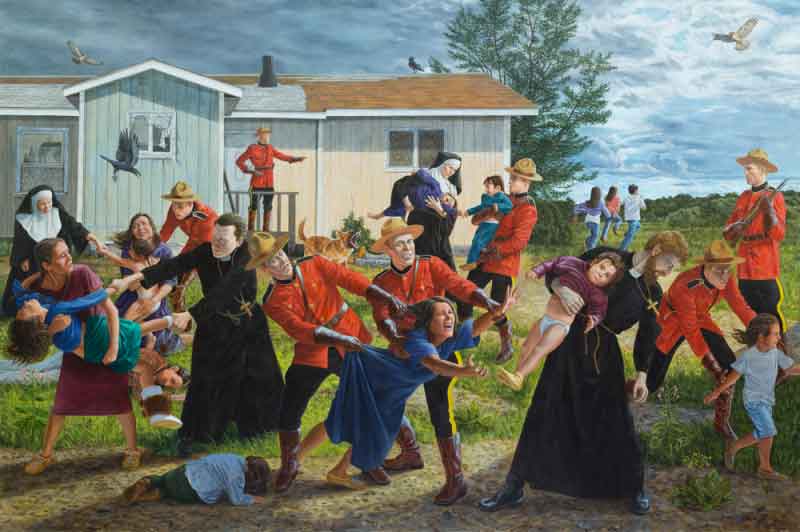By Sean Carleton
Many Canadians have a hard time believing that Canada’s federal police force, the RCMP, is a paramilitary force with a long history of violence. Images of RCMP officers, some dressed in camo gear and armed with automatic rifles, raiding and arresting Indigenous land defenders in Wet’suwet’en territory in 2019 and 2020 clashed with the popular mythology of the Mounties. The stark contrast between the galloping Mounties of the Musical Ride and the militarized police force sent in to be the muscle for an energy company has led some Canadians to view recent RCMP raids of Indigenous land defenders as anomalies.
History, however, proves otherwise. The RCMP’s ongoing operation in Wet’suwet’en territory is part of a pattern of the force being used by the state to suppress Indigenous resistance and clear the way for continued capitalist accumulation by colonial dispossession. In fact, the Mounties have been serving and protecting Canada’s settler capitalist status quo since its creation in 1873.
The Birth of the RCMP
It is important to understand the RCMP’s role as a colonial paramilitary force in its historical context. Drawing on examples of other colonial paramilitary forces in existence around the British Empire in the mid-to-late nineteenth century, such as the Royal Irish Constabulary created in 1822 as part of England’s colonial rule of Ireland, Canada’s first prime minister, John A. Macdonald, created the RCMP’s predecessor – the North-West Mounted Police (NWMP) – in 1873. He wanted to use the new force to help extend Canada’s colonial control over Indigenous territories in what would become Western Canada and clear the way for settlement.
At the time, the country was only six years old, the settler population was not very large, and Canada did not have an independent military. Yet, like the United States, it had ambitions of western expansion. But the Red River Resistance of 1869–1870 showed Canada that Indigenous Peoples were a force to be reckoned with.
Then, in the wake of the Cypress Hills Massacre (a mass murder of Assiniboine peoples by American whisky traders on June 1, 1873), Macdonald tasked the newly-formed NWMP with marching west and containing Indigenous resistance on the prairies so as to guard against possible American annexation. This part of the origin story of the NWMP/RCMP often gets mythologized as the Mounties acting benevolently and trying to protect Indigenous Peoples, but in reality the first use of the force was part of Canada’s process of western colonization. Macdonald was attempting to secure access to the region and its resources with force if necessary.
RCMP and Treaties
The Mounties also played roles in convincing Indigenous Nations to sign onto the Number Treaties on the prairies, being particularly influential in Treaty 7 negotiations in Southern Alberta in 1877. Afterwards, the police ensured there was no resistance as Indigenous Peoples relocated onto reserves to help clear the way for the construction of the Canadian Pacific Railway. In 1885, the NWMP joined Canada’s military forces in war against different Métis, Cree, Assiniboine, and Saulteaux communities in the west as part of the effort, in the words of John A. Macdonald, to “convince the Red Man that the White Man governs.” The execution of Métis leader Louis Riel took place in 1886 in Regina at the NWMP barracks, what is today the RCMP training academy.

RCMP and the Rule of Colonial Law
In the early twentieth century, the police surveilled Indigenous organizers, such as F.O. Loft, and they enforced “the rule of law” by acting as truant officers and removing Indigenous children from their communities and taking them to residential schools.

This history is difficult for some Canadians to accept, especially those who still cling to the mythology of the Mounties as red-coated riders who brought “law and order” to the west. In reality, the police were created to serve and protect the interests of settler capitalism and Canadian nation-building.
In recent years, the force has continued to play a central role in suppressing Indigenous resistance. Many of these conflicts have been captured on film. Below is a survey of some of the notable uses of the force to contain and suppress Indigenous resistance. These events are part of what Sioux scholar Nick Estes calls an “accumulation of prior anti-colonial experiences, sentiments, and struggles.”
In 1968, the Ontario Provincial Police and the RCMP illegally arrested a number of Mohawk citizens of Akwesasne who blocked a bridge built through their reserve near Cornwall, Ontario without proper consultation and in contravention of the 1794 Jay Treaty.
In 1980, the RCMP arrested several members of the Blood Tribe when they staged a blockade along Highway 5, a stretch of blacktop that divides the reserve and the town of Cardston, Alberta, to pressure the federal government to resolve an outstanding land claim.
In 1990, during the Oka conflict Mohawks at Kanehsatà:ke endured a 78-day siege by the SQ, the RCMP, and the Canadian military for opposing the expansion of a nine-hole golf course on unceded Kanien’kéha:ka territory.
In 1995, the Ontario Provincial Police shot and killed Ojibwa activist Dudley George during the Ipperwash Crisis. That same year, the RCMP carried out a 31-day siege of Secwepemc territory and arrested numerous Ts’peten land defenders during the Gustafsen Lake Standoff in BC.
In 2013, the RCMP arrested more than 40 members of the Elsipogtog First Nation in New Brunswick for blocking a road to resist shale gas and fracking activity on their territory.
In January 2019, the RCMP invaded Wet’suwet’en territory and arrested land defenders at the Unist’ot’en camp, and they repeated these raids in 2020. RCMP operations in unceded Wet’suwet’en territory continue today.
This long list of incidents demonstrates that the most recent events in Wet’suwet’en territory are part of a long historical pattern. The RCMP’s sesquicentennial, then, is a good opportunity to move beyond Mountie mythology and commit to understanding the real, violent history behind the force.
Sean Carleton is an assistant professor of history and Indigenous studies at the University of Manitoba. He is the author of Lessons in Legitimacy: Colonialism, Capitalism, and the Rise of State Schooling in British Columbia (UBC Press, 2022). An earlier version of this article appeared here.